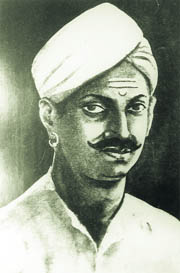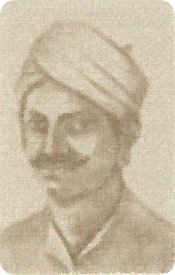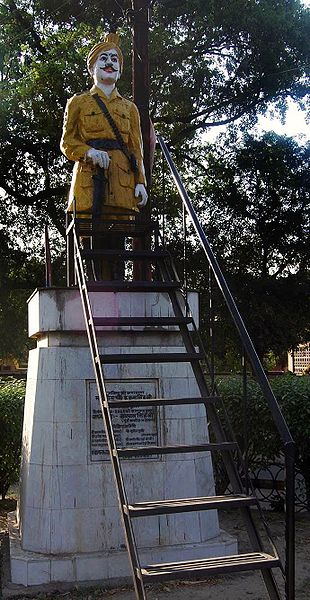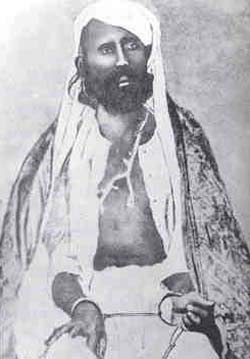<Back to Index>
- Indian Revolutionary Mangal Pandey, 1827
- Indian Revolutionary Dhan Singh Gurjar, 1800+
- General of the Maratha Empire Ramachandra Pandurang Tope, 1814
PAGE SPONSOR


Mangal Pandey (19 July 1827 – 8 April 1857) (Hindi: मंगल पांडे, Bangla: মঙ্গল পান্ডে, Kannada: ಮಂಗಲ್ ಪಾಂಡೆ, Malayalam: മംഗൽ പാണ്ഡേ, Marathi: मंगल पांडे, Tamil: மங்கள் பாண்டே,Telugu: మంగళ్ పాండే) was a sepoy in the 34th Regiment of the Bengal Native Infantry (BNI) of the English East India Company. He is widely known in India as one of its first freedom fighters. The Indian government has issued an Indian Postage Stamp to commemorate him as a distinguished freedom fighter. Beyond that his life and actions have also been adapted to the silver screen.
Mangal Pandey was born on 19 July 1827 in the village Nagwa, of Ballia district in Uttar Pradesh, India, to a Bhumihar Brahmin family.
He joined the East India Company's forces in 1849 at the age of 22. Pandey was part of the 6th Company of
the 34th Bengal Native Infantry and is primarily known for his
involvement in an attack on several of the regiment's officers. This
incident marked an opening stage in what came to be known as the Sepoy Mutiny of 1857 or the First War of Indian Independence. It is said that Pandey was a devout Hindu who practiced his religion diligently.
At Barrackpore on the afternoon of March 29, 1857, Lieutenant Baugh, Adjutant of the 34th Bengal Native Infantry (BNI), was informed that several men of his regiment were in an excited state. Further, it was reported to him that one of them, Mangal Pandey, was pacing in front of the regiment's guard room by the parade ground, armed with a loaded musket, calling upon the men to rebel and threatening to shoot the first European he set his eyes on. Baugh immediately buckled on his sword, placed loaded pistols in his holsters, mounted his horse, and galloped to the lines. Pandey took position behind the station gun, which was in front of the quarter - guard of the 34th, took aim at Baugh and fired. He missed Baugh, but the bullet struck his horse in the flank, and horse and rider were brought down. Baugh quickly disentangled himself and, seizing one of his pistols, advanced towards Pandey and fired. He missed. Before Baugh could draw his sword, Pandey attacked him with a talwar (a heavy Indian sword) and closing with the adjutant, slashed him on the shoulder and neck and brought him to the ground. It was then that another sepoy, Shaikh Paltu, intervened and tried to restrain Pandey even as he tried to reload his musket.
English Sergeant - Major Hewson, had arrived on the ground, summoned by a native officer, before Baugh. He had ordered Jemadar Ishwari Prasad, the Indian officer in command of the quarter - guard, to arrest Mangal Pandey. To this, the jemadar expostulated that his NCOs had gone for help and that he could not take Pandey by himself. At this, Hewson ordered Ishwari Prasad to fall in his guard with loaded weapons. In the meantime, Baugh had arrived on the field shouting 'Where is he? Where is he?' Hewson called out to Baugh, 'Ride to the right, Sir, for your life. The sepoy will fire at you!' At that point Pandey fired.
Hewson had charged towards Pandey as he was fighting with Lieutenant Baugh. He then locked in combat with Pandey and was knocked to the ground from behind by a blow from Pandey's musket. The sound of the firing had brought other sepoys from the barracks; they remained mute spectators. At this juncture, Shaikh Paltu, while trying to defend the two Englishmen called upon the other sepoys to assist him. Assailed by other sepoys, who threw stones and shoes at his back, he called on the guard to help him hold Pandey, but they threatened to shoot him if he did not let go of Pandey.
Some of the sepoys of the quarter - guard then advanced and struck at the two prostrate officers. They then threatened Shaikh Paltu and ordered him to release Pandey, whom he had been vainly trying to hold back. However, Paltu continued to hold Pandey until Baugh and the sergeant - major had had time to get up. Himself wounded by now, Paltu was obliged to loosen his grip. He backed away in one direction and Baugh and Hewson in another, while being struck with the butt ends of the guards' muskets.
In the meantime, report of the incident had been carried to the commanding officer General Hearsey, who then galloped to the ground with his two sons. Taking in the scene, he rode up to the guard, drew his pistol and ordered them to do their duty by seizing Mangal Pandey. The General threatened to shoot the first man who disobeyed. The men of the guard fell in and followed Hearsey towards Pandey. Pandey then put the muzzle of the musket to his breast and discharged it by pressing the trigger with his foot. He collapsed bleeding and with his regimental jacket on fire but not mortally wounded.
Pandey recovered and was brought to trial less than a week later. When asked whether he had been under the influence of any substances, he admitted to having used bhang (cannabis) and opium of late. He pleaded to not knowing what he was doing when intoxicated. He stated steadfastly that he had mutinied on his own accord and that none had played any role in egging him on. When asked to defend himself, he said, "I did not know what I was doing. I did not know who I wounded and who I did not. What more shall I say? I have nothing more to say. I have no evidence". He was sentenced to death by hanging along with the jemadar after three Sikh members of the quarter - guard testified that the latter had ordered them not to arrest Pandey".
Mangal
Pandey's execution was scheduled for April 18, but was carried out ten
days before that date. Jemadar Ishwari Prasad was executed by hanging on
April 21.
The primary motivation behind Mangal Pandey's behavior is attributed to a new type of bullet cartridge used in the Enfield P-53 rifle which was to be introduced in the Bengal Army that year.
The cartridge was rumored to have been greased with animal fat, primarily from pigs and cows, which could not be consumed by Muslims and Hindus respectively (the former being abhorrent to Muslims and the latter a holy animal of the Hindus). The cartridges had to be bitten at one end before use. The Indian troops were of the opinion that this was an intentional act of the British, with the aim of defiling their religions.
Commandant Wheeler of the 34th BNI was known as a zealous Christian preacher, and this may also have impacted the Company's behavior. The wife of Captain William Halliday of 56th BNI had the Bible printed in Urdu and Devanagari and distributed among the sepoys, thus raising suspicions amongst them that the British were intent on converting them to Christianity.
Also, the 19th and 34th Bengal Native Infantry were stationed at Lucknow during the time of annexation of Oudh because of alleged misgovernment by the Nawab, on February 7, 1856. The annexation had another implication for sepoys in the Bengal Army (a significant portion of whom came from that princely state). Before the annexation, these sepoys had the right to petition the British Resident at Lucknow for justice — a significant privilege in the context of native courts. As a result of the annexation, they lost that right, since that state no longer existed. Moreover, this action was seen by the residents of the state as an affront to their honor, the annexation being done in violation of an existing treaty.
The sepoys were accordingly affected by the general discontent which had been stirred up by the annexation. In February 1857, both these regiments were situated in Barrackpore.
The
19th Bengal Native Infantry Regiment is important because it was the
regiment charged with testing the new cartridges on February 26, 1857.
However, right up to the mutiny the new rifles had not been issued to
them, and the cartridges in the magazine of the regiment were as free of
grease as they had been through the preceding half century. The paper
used in wrapping the cartridges was of a different color, arousing
suspicions. The non - commissioned officers of the regiment refused to
accept the cartridges on the 26 February. This information was conveyed
to the commanding officer, Colonel Mitchell; he took it upon himself to
try to convince the sepoys that the cartridges were no different from
those they had been accustomed to and that they need not bite it. He
concluded his exhortation with an appeal to the native officers to
uphold the honor of the regiment and a threat to court - martial such
sepoys as refused to accept the cartridge. However, the next morning
the sepoys of the regiment seized their bell of arms (weapons store).
The subsequent conciliatory behavior of Mitchell convinced the sepoys
to return to their barracks. A
Court of Enquiry was ordered which, after an investigation lasting
nearly a month, recommended the disbanding of the regiment. The same was
carried out on the 31 March. The 19th BNI were allowed to retain their
uniforms and provided by the Government with an allowance to return
home.
The P-53 was officially known as the Pattern 1853 Enfield Rifle Musket. Introduced in the British Army by the War Department during 1854 in the Crimean War, they proved very effective at a range of 50 to 300 yards (270 m). It was introduced in the Bengal Army by the East India Company in early 1857. At the time of Mangal Pandey's outbreak rearming of the sepoy regiments with the new weapon was only in its early stages.
The rifle used a Metford - Pritchitt cartridge that required the use of a heavy paper tube containing 2½ drams (68 grains) of musket powder and a 530 grain (34 g), pure lead bullet. As the bullet incorporated no annular grease rings like the French and American minié ball bullets introduced in 1847, it was wrapped with a strip of greased paper to facilitate loading. The cartridge itself was covered with a thin mixture of beeswax and linseed oil for waterproofing (although rumors abounded that it was beef or pork fat).
To
load his rifle, the sepoy had to first bite off the rear of the
cartridge to pour the powder down the barrel. He then inverted the tube
(the projectile was placed in the cartridge base up), pushed the
end portion into the muzzle to the approximate depth of the bullet and
tore off the remaining paper. The bullet could then be easily rammed on
top of the charge.
Since cows are sacred to Hindus and pigs are strictly forbidden to Muslims, the Indian sepoys could be expected to have reservations about the cartridges. Thus when the rumor that animal fat was being used began to circulate, it had a very damaging effect. Other unsettling accounts started spreading. For instance, it was thought that the British planned to make their sepoys outcast in the society to force them to convert to Christianity. Another rumor said the British had adulterated the wheat flour distributed to the sepoys with ground bone - dust of bullocks.
The matter could have been worsened by the fact that an overwhelming number of sepoys in the Bengal Native Infantry were Brahmins from Awadh, Purvanchal and Western Bihar. As Brahmins are generally devout Hindus and therefore vegetarians, they are not supposed to eat or touch meat, the resistance was even stronger.
The Commander - in - Chief, General George Anson reacted by saying, "I'll never give in to their beastly prejudices" and, despite the pleas of his junior officers, he did not compromise.
Later, the British contemplated reducing the discontent by allowing the sepoys to use their own grease made of ghee (clarified butter). Lord Canning sanctioned a proposal of Major - General Hearsey to this effect. However, the proposal was shot down by the Meerut based Adjutant - General of the Army Colonel C. Chester, who felt it would be tantamount to an admission of guilt and could therefore worsen the matter. He falsely claimed that the sepoys had been using cartridges greased with mutton fat for years and that there was therefore no reason to give in now. This claim was not correct as native sepoys had till then only used Brown Bess muskets for which un-smeared paper cartridges were employed. The government let itself be convinced and rescinded the order allowing the usage of ghee.
The attack by, and punishment of, Pandey is widely seen as the opening scene of what came to be known as the Indian Rebellion of 1857. He is referred as Shaheed (Martyr) Mangal Pandey in India.

Kotwal Dhan Singh Gurjar was one of the freedom fighters of the Indian Rebellion of 1857.
He was born in village Panchali in Meerut, Uttar Pradesh.
The freedom movement, which started in 1822 from Kunja Bahadurpur, came to shape in 1857. In the Indian mutiny of 1857, the mutineers had the support of the army. Dhan Singh Gurjar, at this time the Kotwal of Meerut, was the leader of this initial battle.
On 10 May 1857 Dhan Singh Gurjar opened the gate of the prison in Meerut; this act launched the rebellion. People took up weapons and marched to kill the British. Important places in Meerut were captured. After completing the task at Meerut, the revolutionaries marched towards Delhi, with the slogan "Dilli Chalo".
In memory of this martyr of the 1857 rebellion, the newly built campus community center of Meerut University is named after him.

Ramachandra Pandurang Tope (1814 – 18 April 1859), popularly known as Tatya Tope (Marathi: तात्या टोपे) (pronounced Toh-pey), was an Indian leader in the Indian Rebellion of 1857and one of its finest generals. He was a personal adherent of Nana Sahib of Kanpur. He progressed with the Gwalior contingent after the British reoccupation of Kanpur and forced General Windham to retreat from Kanpur. Later on, he came to the rescue of Rani Laxmi Bai. However he was defeated by General Napier's British Indian troops after the betrayal of his trusted friend Man Singh. He was executed by the British Government at Shivpuri on 18 April 1859.
Born in a village called Yeola in Maharashtra, he was the only son of Pandurang Rao Tope and his wife Rukhmabai. In 1814, when James Andrew Broun - Ramsay, 1st Marquess of Dalhousie deprived Nana Sahib of his father's pension, Tatya Tope also became a sworn enemy of the British.
Tatya Tope was Nana Sahib's close associate and general. During the Siege of Cawnpore in 1857, Nana Sahib's forces attacked the British entrenchment at Kanpur in June 1857. The low supplies of food, water and medicine added to the misery of the British Forces who decided to surrender in return for a safe passage to Allahabad. Nana Sahib agreed to this and made arrangements as best as he could. However, under ambiguous circumstances, the evacuation of the British from Cawnpore turned into a conflict at the Satichaura Ghat. Though controversy surrounds what exactly happened next at the Satichaura Ghat, and who fired the first shot, it is known that soon afterwards, the departing British were attacked by the rebel sepoys. After the conflict began, Tatya Tope allegedly ordered the 2nd Bengal Cavalry unit and some artillery units to open fire on the British. Many of General Wheelers men were either killed or captured. The surviving British women and children were moved from the Savada House to Bibighar "the House of the Ladies", a villa type house in Kanpur.
Nana Sahib decided to use the captives for bargaining with the East India Company. The Company forces from Allahabad, under the command of General Henry Havelock, advanced relentlessly towards Cawnpore. Two forces sent by Nana Sahib to check their advance were defeated. When it became clear that the bargaining attempts had failed, an order was given to murder the women and children imprisoned at Bibighar, on July 15. The details of the incident, such as who ordered the massacre, are not clear. The sepoys refused to kill the captive women and children, but some of them agreed to remove the women and children from the courtyard, when Tatya Tope threatened to execute them for dereliction of duty. Begum Hussaini Khanum, the in-charge of Bibighar, termed the sepoys' act as cowardice, and asked her lover Sarvur Khan to finish the job of killing the captives. Sarvur Khan hired some butchers, who murdered the surviving women and children with cleavers.
The
Company forces reached Cawnpore on July 16, and captured the city. Both
Nana Sahib and Tatya Tope escaped from the city. While Nana Sahib fled
to an unknown place, Tatya Tope continued the fight against the British.
In November 1857, he gathered a large army, mainly consisting of the
rebel soldiers from the Gwalior contingent, to recapture Cawnpore. By
November 19, Tatya Tope's advance guard of 6,000 dominated all the
routes west and north-west of Cawnpore. However, his forces were
defeated by the Company forces under Colin Campbell in the Second Battle of Cawnpore, marking the end of the rebellion in the Cawnpore area. Tatya Tope then joined Rani Lakshmibai.
After losing Gwalior to the British, Tope launched a successful campaign in the Sagar, Madhya Pradesh and Narmada River regions and in Khandesh and Rajasthan. He took shelter for some time in Nadiad ni haveli with Bhausaheb Desai of Nadiad. The British forces failed to subdue him for over a year. He was however betrayed into the hands of the British by his trusted friend, Man Singh, Chief of Narwar while asleep in his camp in the Paron forest. He was defeated and captured on 7 April 1859 by British General Richard John Meade's troops and escorted to Shivpuri where he was tried by a military court.
Tope admitted the charges brought before him saying that he was answerable to his master Peshwa only. He was executed at the gallows on April 18 1859. There is a statue of Tatya Tope at the site of his execution near the present collectorate in Shivpuri town in Madhya Pradesh.